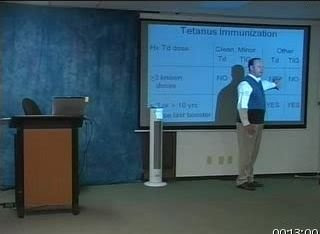Contents
ALS Algorithm
Useful phone and bleep numbers
CHAPTER 1
GOOD CLINICAL PRACTICE
Introduction
General Points
Professional Responsibilities
Good Documentation
Good Prescribing
Practical Procedures
Talking with Patients and Relatives
Patient Deaths
Organ Donation
Discharges: Good Practice
Guide to Good Discharge Summaries
CHAPTER 2
RECOGNITION ASSESSMENT AND MANAGEMENT OF THE ACUTELY ILL ADULT
Primary Assessment and Management: Approach to the Acutely Ill Patient
Identification of the Acutely Ill Patient Requiring Intensive Care or High Dependency Unit Referral
Shock
Shock Management Summary
Blood and Blood Components
Transfusion Reactions
Sepsis and Septic Shock
Anaphylaxis
Algorithm for First Trained Responder to Anaphylaxis
Urticaria and Angio-oedema
Life-threatening Upper Airway Obstruction
Acute
Summary of Principles of Acute Care
Approach to the patient with
Chest Pain
Acute Shortness of Breath
First Seizure in Adults
Management of First Seizure in Adults
Management of Syncope
Management of Unexplained Syncope in Adults
Management of Collapse
Management of Renal Colic
Resuscitation
Adult Advanced Life Support Algorithm
Algorithm for Automated External Defibrillation
CHAPTER 3
ACUTE CARDIOLOGY AND VASCULAR EMERGENCIES
Based on Coronary Care Therapeutic Schedule (RIE)
General Administrative Policy
Acute Coronary Syndromes
Management of ST Elevation Acute Coronary Syndrome
Management of Non-ST Elevation Acute Coronary Syndrome
Management of other Acute Coronary Syndromes
Management of Complications Associated with Myocardial Infarction
Severe Left Ventricular Failure
Cardiogenic Shock
Diabetic Control in Acute Myocardial Infarction
Late Management of Acute Myocardial Infarction
Other Potential Problems in the Peri-infarct Period
Other Medical Emergencies Admitted to CCU
Out of Hospital Cardiac Arrest
Management of Arrhythmias
Tachyarrhythmias
Atrial Fibrillation Algorithm
Narrow Complex Tachycardia Algorithm
Broad Complex Arrhythmias
Diagnosis of Broad Complex Tachycardia
Management of Bradyarrhythmias
Bradycardia Algorithm
External Cardiac Pacing
Specific Drug Points
Vascular Emergencies
Acute Thoracic Aortic Dissection
Investigation Algorithm for Acute Aortic Dissection
Acute Stroke
Thromboembolic
Suspected Pulmonary Embolism
Ruptured or Leaking Abdominal Aortic Aneurysm
Management of the Acutely Ischaemic Limb
Hypertension
CHAPTER 4
RESPIRATORY EMERGENCIES
Severe Acute Asthma
Community-Acquired Pneumonia
Hospital-Acquired Pneumonia
Pneumothorax
Spontaneous Pneumothorax
Tension Pneumothorax
Intercostal Drainage Tube Insertion
CHAPTER 5
GASTROINTESTINAL EMERGENCIES
Acute Upper Gastrointestinal Bleeding
Treatment and Assessment
Acute on Chronic Liver Failure
Acute Bloody Diarrhoea
Acute Diarrhoea
Constipation
Assessment of Acute Abdomen
Acute Pancreatitis
CHAPTER 6
RENAL, METABOLIC AND ENDOCRINE EMERGENCIES
Acute Renal Failure
Dangerous Hyperkalaemia
Metabolic Acidosis
Management of Diabetic Ketoacidosis
Management of Diabetic Hyperosmolar Non-Ketotic Syndrome
Hypoglycaemia
Sulphonylurea-induced Hypoglycaemia (SIH)
Hypercalcaemia
Hypocalcaemia – the 5 Common Causes
Hypokalaemia
Addison’s Disease
Hyponatraemia
CHAPTER 7
NEUROLOGICAL EMERGENCIES
Coma
Clinical Assessment of coma
Epileptic Seizures
Subarachnoid Haemorrhage
Meningitis
Tentorial Herniation and Coning
Encephalitis
Spinal Cord Compression
CHAPTER 8
ACUTE DETERIORATION IN THE ELDERLY
Delirium
Acute Agitated Confusion in an Older Patient
Falls and Immobility
CHAPTER 9Neutropenic Sepsis
EMERGENCIES IN HAEMATOLOGY, ONCOLOGY & PALLIATIVE CARE
Superior Vena Cava Obstruction
Emergencies in Palliative care
Hypercalaemia in Palliative care
Seizures in Palliative care
Spinal cord compression
Naloxone in Palliative care
Care of the dying patient
Standards of care for dying patients LUHT department of medicine for the elderly
The role of junior medical staff in the diagnosis of dying
CHAPTER 10
TOXICOLOGY
A Guide to Observations and Investigations for the Patient with Acute Poisoning
Management of Common Poisonings
CHAPTER 11
ACUTE REHMATOLOGY
Acute Mono or Oligoarthritis
CHAPTER 12
PSYCHOLOGICAL MEDICINE
Alcohol
Management of Alcohol Withdrawal
Alcohol Withdrawal Management Guideline
Alcohol Liaison Service
Acute Disturbance
APPENDIX 1
Sharing Difficult Information with Patients/Relatives
APPENDIX 2
End of Life Care
APPENDIX 3
General Principles of Good Practice: Infusion Devices
APPENDIX 4
Resuscitation: Specialised Information
Pregnancy
APPENDIX 5
Paediatric Basic Life Support
Foreign Body Obstruction Sequence
Consent to Medical Treatment for Children in Scotland
APPENDIX 6
Malignant Hyperthermia Action Sheets NRIE/WGH
Major Haemorrhage Protocol
Read more...


















